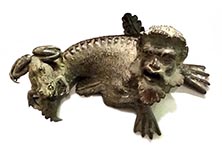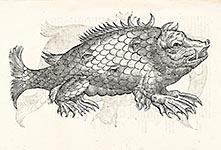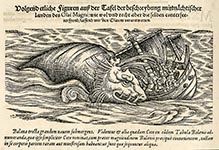(Sea) Monsters
Not a sea monster at all, but the people who used this image make for an interesting source and story:
(152c)
(152b) The text reads: "in the year 1547, at Cracovia (Krakow) a very strange monster was born which liced for three days".
It is published (1554?)in 'The Expert Midwife' a handbook on midwifery by Jacob RUEFF (Ryff, Rüff) -1500-1558
Born in Württemberg, fl. Zurich. Physician and surgeon. Author of medical treatises on tumours, bloodletting and midwifery. Also a poet and writer of folk songs.
Link: britishmuseum.org (007) Adriaen COENENSZ. from Scheveningen used the same image in his 'Visbook' (produced 1577-1580) see the next page on more from Adriaen
Little is known of Jacob Rueff's early life except that he was born in 1500, some say in Rhyntal, others in Württemberg. Settling in Zurich he became prominent in many fields. Although primarily known as a physician, surgeon, and lithotomist, he was also a poet and writer of folk songs. He was a follower of Martin Luther and a great believer in religious freedom; indeed twice, at the age of 29 and 31, he served with the troops of Zurich against the Catholic cantons.1 ,2 His medical writings include a little book on tumours, astronomical notes for an almanac, and charts for blood letting. But easily his most important contribution was the publication of a practical handbook on midwifery in 1554. Published simultaneously in Latin and German, De conceptu et generatione hominis . . . 3 became the required reading for the midwives of Zurich, for whose instruction and examination Rueff was made responsible.
In 1637 an English translation was published in London with the title 'The expert midwife.' The last edition of this work appeared in Amsterdam in 1670. Thus Rueff's book was for over a century a major source of information for midwives and doctors. As he wrote: “ . . .my labours I bequeath to all grave modest and discreet women, as also to such as by profession, practice either physicke or chirurgery. And whose helpe upon occasion of extreame necessity may be usefull and good both for mother, child and midwife.”
fn.bmj.com
"Jacob Rueff, "De Conceptu Et Generatione Hominis" (Frankfurt am Main, Sigmund Feyerabend) 1580; containing woodcuts by Jost AMMAN printed throughout the text illustrating female anatomy and the womb, scenes of childbirth, foetuses, forceps and other gynaecological equipment, conjoined twins and other birth abnormalities. Bound together with titlepage printed with a vignette showing a woman in bed at left, surrounded by midwives, and a new-born baby being bathed in the foreground. Vellum binding."
britishmuseum.org
(152c)
(152b) The text reads: "in the year 1547, at Cracovia (Krakow) a very strange monster was born which liced for three days".
It is published (1554?)in 'The Expert Midwife' a handbook on midwifery by Jacob RUEFF (Ryff, Rüff) -1500-1558
Born in Württemberg, fl. Zurich. Physician and surgeon. Author of medical treatises on tumours, bloodletting and midwifery. Also a poet and writer of folk songs.
Link: britishmuseum.org (007) Adriaen COENENSZ. from Scheveningen used the same image in his 'Visbook' (produced 1577-1580) see the next page on more from Adriaen
More on Jacob RUEFF:
Little is known of Jacob Rueff's early life except that he was born in 1500, some say in Rhyntal, others in Württemberg. Settling in Zurich he became prominent in many fields. Although primarily known as a physician, surgeon, and lithotomist, he was also a poet and writer of folk songs. He was a follower of Martin Luther and a great believer in religious freedom; indeed twice, at the age of 29 and 31, he served with the troops of Zurich against the Catholic cantons.1 ,2 His medical writings include a little book on tumours, astronomical notes for an almanac, and charts for blood letting. But easily his most important contribution was the publication of a practical handbook on midwifery in 1554. Published simultaneously in Latin and German, De conceptu et generatione hominis . . . 3 became the required reading for the midwives of Zurich, for whose instruction and examination Rueff was made responsible.
In 1637 an English translation was published in London with the title 'The expert midwife.' The last edition of this work appeared in Amsterdam in 1670. Thus Rueff's book was for over a century a major source of information for midwives and doctors. As he wrote: “ . . .my labours I bequeath to all grave modest and discreet women, as also to such as by profession, practice either physicke or chirurgery. And whose helpe upon occasion of extreame necessity may be usefull and good both for mother, child and midwife.”
fn.bmj.com
"Jacob Rueff, "De Conceptu Et Generatione Hominis" (Frankfurt am Main, Sigmund Feyerabend) 1580; containing woodcuts by Jost AMMAN printed throughout the text illustrating female anatomy and the womb, scenes of childbirth, foetuses, forceps and other gynaecological equipment, conjoined twins and other birth abnormalities. Bound together with titlepage printed with a vignette showing a woman in bed at left, surrounded by midwives, and a new-born baby being bathed in the foreground. Vellum binding."
britishmuseum.org
tags: #monster #jacob Rueff #adriaen coenensz vischbooc #visboek #the expert midwife #jost amman
151 -King Manuel of Portugal rides a seamonster
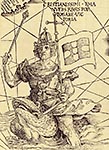 On a detail of Martin Waldseemüller's 'Carta Marina' (1516), King Manuel of Portugal rides a sea monster, located off the southern tip of Africa.
It´s good to be the king, with a nod to Portugal's maritime dominance at the time.
On a detail of Martin Waldseemüller's 'Carta Marina' (1516), King Manuel of Portugal rides a sea monster, located off the southern tip of Africa.
It´s good to be the king, with a nod to Portugal's maritime dominance at the time.©: Library of Congress
read Chet Van Duzer´s book Sea Monsters on Medieval and Renaissance Maps
tags: #Carta Marina #King Manuel of Portugal #Martin Wallseemueller
152 'Ocean Memory' game -Monstrum Marinum rudimenta habitus Episcopi referens
'Monstrorum Historia' Woodcut illustrations from ALDROVANDI's 'History of Monsters'"Ulissi Aldrovandi (Aldrovandus) (1522-1605) graduated from Padua and Bologna Universities with degrees in law, philosophy and medicine and taught logic to supplement the occasional patronage bestowed on him by his cousin, the Pope.
During nearly a year of confinement in Rome while fighting a heresy charge, Aldrovandi developed a strong interest in the natural world. He began to collect all manner of specimens which apparently came to constitute a formidable natural history museum for those that visited him.
He travelled quite a bit in his quest for specimens and reco, ed his observations in some 4000 manuscripts, a number of which were published during his lifetime. His writings include studies in ornithology, medicine, hydrology, zoology, botany and, as can be imagined from the embellished and fantastical images here, a paper on mythical creatures as well (among others).
Aldrovandi was instrumental in establishing the botanical gardens in Bologna and his alma mater there awarded him the first Professorial chair in natural science."
© text: bibliodyssey.blogspot.nl
The sea bishop or bishop-fish was a type of sea monster reported in the 16th century. According to legend, it was taken to the King of Poland, who wished to keep it. It was also shown to a group of Catholic bishops, to whom the bishop-fish gestured, appealing to be released. They granted its wish, at which point it made the sign of the cross and disappeared into the sea.
Another was supposedly captured in the ocean near Germany in 1531. It refused to eat and died after three days. It was described and pictured in the fourth volume of Conrad Gesner's famous Historiae animalium.
The sea monk (also monk-fish or monkfish) was a sea creature found off the, astern coast of the Danish island of Zealand, almost certainly in 1546. It was described as a "fish" that looked superficially like a monk, and was mentioned and pictured in the fourth volume of Conrad Gesner's famous Historia Animalium. Gesner also referenced a similar monster found in the Firth of Forth, according to Boethius, and a sighting off the coast of Poland in 1531.
The sea monk was subsequently popularised in Guillaume du Bartas's epic poem La Sepmaine; ou, Creation du monde, where the poet speaks of correspondences between land and sea, mentioning both the "mytred Bishop" and the "cowled Fryer":
"Seas have (as well as skies) Sun, Moon, and Stars;
(As well as ayre) Swallows, and Rooks, and Stares;
(As well as earth) Vines, Roses, Nettles, Millions,
, Pinks, Gilliflowers, Mushrooms, and many millions
of other Plants lants (more rare and strange than these)
As very fishes living in the Seas.
And also Rams, Calfs, Horses, Hares, and Hogs,
Wolves, Lions, Urchins, Elephants and Dogs,
Yea, Men and Mayds; and (which I more admire)
The mytred Bishop and the cowled Fryer;
Whereof, examples, (but a few years since)
Were shew'n the Norways, and Polonian Prince."
Steenstrup's comparison of a squid with two drawings of the sea monk from the sixteenth century
In the early 1850´s, Danish zoologist Japetus Steenstrup suggested that the sea-monk was a giant squid, a theory more recently popularised by writer Richard Ellis. Cryptozoologist Bernard Heuvelmans believed the report was based on the discovery of an errant walrus. More recently, it has been suggested that it was an angel shark Squatina squatina, which is commonly called "monkfish" in English or munk in Norwegian and Danish. Other suggested suspects for the sea monk include a grey seal, a hooded seal, a monk seal, or a hoax such as a Jenny Haniver.
©: PD
tags: #Monkfish #Bishopfish #Aldrovandi #sea monster
,
©: PD
152b -Sea Monk
from Olaus Magnus, ´Historia de gentibus septentrionalibus´ named ´Sea Monk on a Rock´ (1555) The woodcut shows a rock in shape of a monk´s frock which is situated in the sea south of the main part of the Faeroe Islands. The Sea Monk (in Danish "Munken") has a safe harbour. To the right we see a wrecked ship. At the island above a raven." Wikipedia©: PD
tags: #Olaus Magnus #Sea Monk
009b -Sea Monsters
Gottfried Franz (1846-1905) - ´The Miraculous Adventures of Baron Münchhausen´ 1896(underwater and fighting seamonsters)
©: PD
,
tags: #Gottfried Franz #Sea monsters
ref. # 010 -´Shipbreaker Kraken´ (Promo Version) - Svetlin VELINOV
©: LinkedIn, Facebook, www.velinov.com, Sofia, Bulgaria
tags: #Kraken #shipbreaker #Svetlin Velinov
153 -Sea Monster
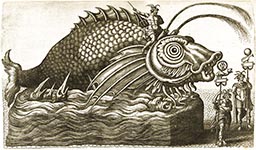 ´Float with Sea Monster´ Pieter van der Borcht
´Float with Sea Monster´ Pieter van der Borcht©: PD
tags: #Seamonster #Pieter van der Borcht
,
,
,
or: "A sea monster bearing away a princess"
Wikipedia
'Das Meerwunder' (the Sea Monster) Albrecht DÜRER ca.1498
©: Creative Commons
154 -'das Meerwunder'
"The Sea Monster is a c. 1498–1500 copper engraving by the German Renaissance master Albrecht Dürer. It shows a voluptuous naked woman riding on the back of a merman, a male creature who is half-man, half-fish. The man wears a beard and antlers, while his lower body is covered in scales."or: "A sea monster bearing away a princess"
Wikipedia
'Das Meerwunder' (the Sea Monster) Albrecht DÜRER ca.1498
©: Creative Commons
tags: #Albrecht Duerer #Sea Monster #das meerwunder

010 'Shipbreaker Kraken', source Svetlin VELINOV

'Sea Monsters: Things from the Sea', Volume 2 Paperback – 29 september 2017
Engelstalige uitgave Thea Tomaini (author), Asa Simon Mittman (editor)
"Beaches are places that give and take, bringing unexpected surprises to society, and pulling essentials away from it. Through monsters, we confront our tiny time between catastrophes and develop a recognition of Otherness by which an ethical understanding of difference becomes possible. Learning to read the monster’s environmental signs often helps humans determine the scope of the monster’s place in the eco/cosmic timeline and defeat it—until the epic cycle inevitably repeats; monsters live and live and live. Even so; when humans identify and confront monsters we do so at the risk of exposing our own monstrosity. When a massive creature is pushed into human proximity by the ocean’s wide shoulders, the waves deposit and erode human assumptions about itself and its environment; words, sounds, breath, water, wind, flesh, blood, and bones wash in and out. Chance encounters reveal us to ourselves anew. When we look into the inky backs of whales, or deep into vortices, what do we see?"
Publication in English: Thea Tomaini (author), Asa Simon Mittman (editor) Link: www.amazon.nl
tags: #Thea Tomaini #Asa Simon Mittman #sea monsters #'Sea Monsters: Things from the Sea', Volume 2 Paperback – 29 september 2017
see also: the 'Roc'







